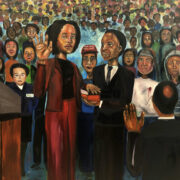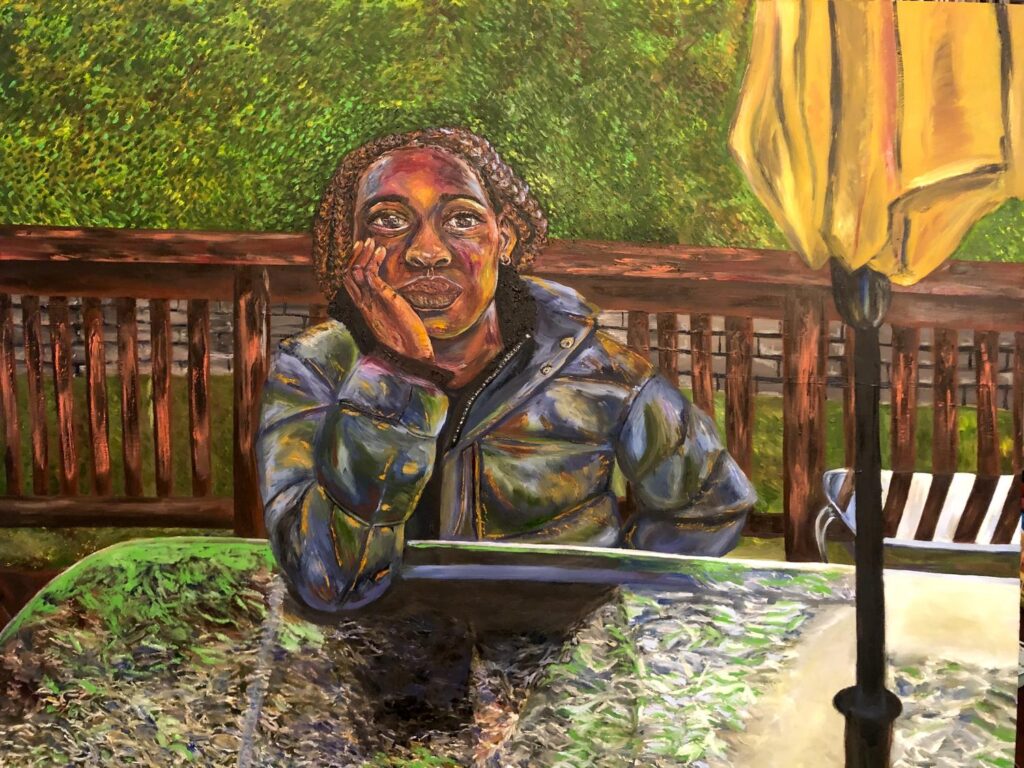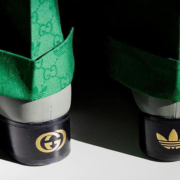Constructing Black Utopias Through Colour and Consciousness with Briana McLaurin

For New Jersey-Hailing artist Briana McLaurin, using art as a form of social commentary has evolved her work into a seemingly beautiful container for nurturing little black worlds that operate and exist outside the lens of identity politics.
Written by Contributing Editor, Olisa Jr.
Briana McLaurin‘s work presents itself as a divine narrative, foretelling a future to come in which Black artists and subjects hold the power of self-authorizing their lived experiences and the representation of it. Poetically employing vibrant tones, powerful subject gaze, and subtle yet compelling reimaginations of her reality, Briana’s work truly extends the bounds of contemporary expression.
In her latest exhibition, at the Thierry Goldberg Gallery, Briana blithely speaks about drawing inspiration from the idea of time, as she often thinks of her paintings as time capsules– as memories or dreams, snapshots of the different seasons in my life. “Round a Melody, as well as Round a Memory (The Artists) and Round a Harmony are based on the beginning stages of my family members’ emerging careers in the beauty industry. They are a part of an unfinished series titled, How It Started, and my plan is to return to this series in ten years and paint the progression of their careers at that time,” she said.
While time is paused and yet to be resumed in these paintings, time stops altogether in the pieces, From Outside (2020), From Inside (2020), and From Both Outside and Inside (2020), each painting depicting a different perspective of the same moment. Moreover, in the untitled pieces for the Coat Series (2019), the influence behind that was my interest in experimenting with texture and capturing the different types of fabric on coats.”

Reaching the end of the weekend, I had the opportunity to speak to Briana about the conceptual depths of her latest exhibition, creating empowering black worlds within each painting, and the role art has served in her life as an individual growing up in New Jersey.
How do your representations of Blackness in your paintings speak to the larger concept of recontextualizing ways in which racial identity is portrayed?
Briana: I would say that my representation of Blackness in my paintings speaks to this concept by portraying scenes in which black people are empowered just by existing, just by being in the moment. It’s a powerful thing to be black and at the moment—whether that moment is the start of a burgeoning career, as displayed in Round a Melody (2021), Round a Memory (The Artists) (2021), and Round a Harmony (2021), or an endless gaze, as in The Coat Series (2019), or even a moment of silence between mother and child, captured in From Outside (2020), From Inside (2020), and From Both Outside and Inside (2020). With my work, I seek to eliminate the boxes that black people are so often placed inside of and embrace the nuances of our experience, an experience that is both grand and quotidian, legendary and anecdotal. We, as black people, are timeless, and we are every day.
What symbolic or conceptual references inspire your work?
Briana: The symbolic or conceptual references that inspire my work have a lot to do with colour, specifically what I love to call “intentional colour.” To me, this means having complete control over one’s colour palette, being bold and strategic in what pigments to use and where to use them. Some of my favourite references can be found in the works of Barkley L. Hendricks. I always go back to one piece, in particular, which is his 1977 piece, Slick (Self Portrait). When I first saw this piece, there were so many things running around in my head. The painting exudes a certain kind of boldness and energy with the colour palette, as Hendricks paints himself in a white suit against a white background and yet still manages to make the colour stand out. There’s a sense of freedom in this—doing exactly what you want to do with intention and confidence. The same can be said about Kerry James Marshall and his amazing devotion to his colour palette, specifically in the colours that he uses for his figures.

Speaking on gaze, all your subjects maintain a direct point of eye contact with the viewers. What dictated that decision, and what is it trying to convey?
Briana: The two main questions that I ask myself as I paint are: “what role do the figures play in this painting?” and “what role do the viewers play in it?” Gaze helps me answer those questions. This point of eye contact with the viewers is where the dialogue begins and essentially never ends. It’s where the viewers and the figures become acquainted and a part of each others’ spaces, where their worlds merge. It is where the painting becomes interactive.
I was particularly drawn to your painting Presidential Election, as it depicts a Black woman being sworn in as President, which would be something of almost a miracle in our current era. Yet, it reshapes the reality of what Blackness can accomplish and creates a new existence that contests the reality of Black artists creating work within the realm of white acceptance. What inspired that painting, and why do you think it was important that it was part of the exhibition?
Briana: This piece was inspired by an idea that I had to paint a black woman in high esteem. I think it was important to include it in this exhibition because, like my other pieces, it has a lot to do with time and representation. I envision this scene as an image from the future, a future in which marginalized people, such as black women, are elevated in American society and recognized and appreciated for this elevation. The goal was to prompt everyone to acknowledge the brave activists of our past, open our eyes to the frightening brutality of our present, and refine our understanding of what African Americans are capable of. I pulled a lot of inspiration from current events. For example, a man standing behind the President appears to be wearing a “Make America Great Again” hat. However, upon a closer glance, one might note that his hat reads, “Make America Great for Once.” I wanted the figures and objects in this piece to engage with the times, to resonate with, interrogate, and re-examine reality.

What messages or themes do you feel yourself, and your work set out to convey, above all else?
Briana: I would say that the first theme that I always work to present is black representation and presence. With my work, I aim to create a space for black people to see themselves in. I didn’t see myself in a painting until I discovered the work of legendary artists such as Lynette Yiadom-Boakye, Amy Sherald, and Mickalene Thomas. My nephew– who’s three years old– once saw a sign at a playground that featured a small, cartoon dark-skinned boy, and immediately, he lit up and shouted, “that’s me!” That excitement of feeling connected to an image, of feeling like you’re in the room like you’re a part of the conversation, is something that inspires my work tremendously. Other themes that I keep in mind as I work are family—I believe a certain level of intimacy emerges when painting faces, especially the faces that you know and love—and time (the moment!), as I mentioned before.
Are there any social, artistic, or political issues that trigger your creative ideation?
Briana: Black erasure in the art world triggers my creative ideation, and not just in the art world but also beyond that. The silencing black people experience in practically every arena—whether that be education or the corporate world, media, or even the environmental world—makes me more desirous of amplifying black voices in my art. Creativity is how I engage with issues that matter to me. It’s how I insert myself into conversations that are happening around me.

What dictates the colours in your palette when capturing your subjects?
Briana: My palette is mostly dictated by the colours in my subjects’ skin. After staring at the faces for long periods of time, I begin to discover new and unexpected colours. From there, I jot down every pigment and bring them to life on my canvas. Also, I love to work with my favourite colour combinations. In this way, I get to bring in my imagination, rather than strictly working from the colours that I see on the figure. For example, there is something so beautiful and melodic about yellow ochre, sap green, and cerulean blue around the bridge of the nose and the eyes; there is something so rhythmic and prominent about emerald green and naphthol red forming the chin and the cheekbones; and there is something so steady, yet delicate about burnt sienna and a light crimson red making up the forehead.
How do you feel growing up in New Jersey affected your artistic aesthetic and focus?
Briana: It was an area where there weren’t many black people, and the school systems never taught black history or acknowledged the black experience at all. I remember first moving there and people asking my family if we were related to the other black family around the corner. I was used to being the only black person in my class, the only black person in a majority of the rooms I’d enter. My friends, family, and I were used to being ostracized and singled out because of how different we looked. That’s one of the reasons why I am so passionate about highlighting black people in my work. Growing up, I always made sure to do my school projects on someone who looked like me because no one else would. I always made sure to research black history because how else would I learn? That’s why I feel so motivated to showcase my community.

What role does art serve in your life?
Briana: Art helps me decipher all of the thoughts and ideas tangled in my mind and translate them into the world. I would say that it makes my voice louder clearer. It makes me feel heard. There’s something about painting on a large canvas that almost makes it impossible for people to look away. Likewise, there’s something about painting black people on a large canvas that almost makes it impossible for people to disengage. That being said, art allows me to create the world that I want to see. One in which black people are represented everywhere, in which we are the expectation and not the exception.
Written by Contributing Editor, Olisa Jr.
Check out the GUAP Arts & Culture section, to discover new art, film, and creative individuals.

